Introduction to the Company
Emirates Airlines, mostly known simply as Emirates, is one of the leading airline companies in the global aviation sector. Founded on March 25, 1985, the company was meant to address the market gap that was created by the decision of Gulf Air to scale down its scheduled flights from and to the city of Dubai (Bamber et al. 23). The government of Dubai was concerned that the move would affect the city that had started experiencing impressive growth because of its strategic location as a trade route. Headquartered in Dubai, Emirates serves the global market. The company experienced rapid growth in its first two decades of operation.
It was instrumental in the growth of Dubai city as a global business and tourist hub. According to Andersen and Poulfelt, Emirates is currently ranked fourth-largest airline in the world is based on revenue (34). It holds the same position in terms of the number of international passengers that it carries to various destinations around the world. It comes second based on the freight ton-kilometers that are flown. It is currently the largest airline company in the Middle East and North Africa region. Emirates is wholly owned by the Emirates Group, which is a Dubai government’s entity. The current chairman, who is also the chief executive officer of the company, is Ahmed bin Saeed Al Maktoum, while Tim Clark serves as its president (Andersen and Poulfelt 23). The recent records of the company show that it has about 64,768 employees working in various parts of the world. In this report, the researcher will focus on auditing Emirates’ brand in the current competitive aviation market.
Situation Analysis
The internal environment and the external forces both have a direct impact on the ability of a firm to achieve success in the market. When conducting a brand audit, it may be necessary to investigate these forces. SWOT, PEST, and Company analysis will be critical at this stage to understand the forces that Emirates Airline has to deal with in its normal market operations.
SWOT Analysis
Emirates is currently the leading airline in the MENA region. One of the firm’s strengths is the impressive revenues that it makes regularly. Bamber et al. note that the strategies used by the company have enabled it to make an impressive profit at a time when other airlines are registering losses (31). The high volume of cargo and the number of passengers that it carries also help in boosting its revenue in the market. The firm has diversified its products beyond passengers. It is currently the second-largest cargo carrier in the global aviation industry. The main weakness of this firm is its inability to manage the needs and interests of its employees. The company is always keen on embracing emerging technologies to help it meet the needs of its customers in a better way. Some of its pilots and flight attendants have complained of being overworked.
The market offers various opportunities that have enabled the firm to register impressive growth over the recent past. Dubai, which if its headquarters, has become a major tourist destination in the world. The city is also a major business hub, especially for companies in the Far East such as China and Japan (Andersen and Poulfelt 67). It means that the number of people traveling to Dubai has increased, creating a perfect opportunity for the airline. The steady economic growth locally and internationally offers this firm opportunity to grow because the purchasing power of potential travelers is increased. Emerging technologies also offer impressive growth opportunities in terms of enhancing security and coordination, improving the comfort of passengers, and making online sales. However, the company must be ready to deal with the threats in the external environment, the top of which is stiff competition from rivals such as Etihad Airways, Qatar Airways, and British Airways.
PEST Analysis
The external environment can also be examined using PEST analysis. The political environment in the United Arab Emirates has been instrumental in the growth of the company. The political leaders have ensured that the country is secured from any political unrest. The economic environment both locally and internationally has also benefited the firm. Other than the 2009 global economic recession that affected the aviation sector, many economies around the world have remained stable. It means that more people are willing and able to fly from other parts of the world to Dubai and vice versa. The social environment in Dubai is changing. The society is embracing the changing socio-cultural forces, which is attracting the international community. Technology is also playing a critical role in promoting the growth of this company, as discussed in the section above.
Competitive Analysis
The aviation industry is highly competitive. Emirates has to deal with stiff competition from local, regional, and global airlines. Etihad Airways and Qatar Airways are the top regional competitors. These rivals also have strong brands in the global aviation industry. At the global level, this firm has to deal with British Airways, Virgin Atlantic, Japan Airlines, and Lufthansa among other top brands. Bamber et al. note that the competition in the aviation industry is so stiff that any slight mistake of one company can easily lead to a massive shift of loyalty to other brands (32). Emirates must be careful not to give its customers reasons to consider using other airlines.
Customer-Based Brand Equity Model
Customer-based brand equity analysis can help in further examination of the Emirates brand in the aviation sector. Holland and Lam define brand equity as “the value of having a well-known brand name, based on the idea that the owner of a well-known brand name can generate more revenue simply from brand recognition,” (63). In many cases, customers prefer purchasing products from well-known brands. They associate certain brands with high quality. The figure below shows the steps that should be taken to build strong customer-based brand equity.

As shown in the figure above, the bottom of the pyramid is brand silence. The majority of brands are at this level of the pyramid because it does not require much to belong. The brand is silent in the market. Many customers cannot easily identify the brand. It is a dangerous position to be in because a firm cannot generate any competitive advantage over market rivals using such a weak brand. Emirates is beyond this level in the aviation market. The second stage involves defining what you are in the market, with performance and imagery being the building blocks. The services of the company must meet the needs of customers while at the same time creating a positive image among customers. At this stage, the brand starts gaining significant strength over that of the majority in the market. The image created at this stage may have a lasting impression in the minds of customers. As Trott says, the first experience that a customer has with a brand creates a lasting impression that cannot be changed easily (46). The current strength of the Emirates brand is beyond this level.
In the third stage of the pyramid is the response that a firm gets from its customers, with the building blocks being feelings and judgment. As a brand gains an image in the market based on its performance, many people will try to use its products, some of them doing so for the first time. They will develop a feeling of satisfaction or lack of it, based on their expectations and what they get. Their feeling will transform into judgment. If they had a satisfactory experience, their judgment towards the product and brand would be fair. Otherwise, they will avoid the products and the brand. Going beyond this stage can be very challenging, but it is possible through consistency. The last stage is resonance where a firm develops a close relationship with its customers. It is at this stage that customers start to develop loyalty towards a brand because of their belief that it assures them of high value. Emirates has achieved this level of success in developing a strong brand in the market. Most customers trust this brand because of the quality and reliability of its services.
Brand Portfolio
In a highly competitive market environment, expanding the product portfolio of a brand is critical in increasing a company’s revenues. Emirates has two broad brand portfolios. The first one is the passenger services. According to Andersen and Poulfelt, the company has invested a lot in ensuring that its travelers are offered the best services possible (78). It offers three classes of services to its customers. The first class serves those who need more than just traveling services. They need great comfort, privacy, entertainment, and more. Emirates has them properly covered with tailor-made products designed to meet their unique needs. These passengers can sleep comfortably when on board the planes, watch movies and engage in other activities within the legal scope and capability of the airlines. The next is the business class. It serves the business executives who can afford some comfort but are conscious about their expenses. The last category is the economy class.
These are individuals whose primary goal is to move from one airport to the other. In each of these categories, the company is always keen to ensure that travelers get the comfort needed to make the journey relaxing and enjoyable. The second brand portfolio is Emirates Cargo. As explained above, Dubai is currently one of the most important transit routes and business hubs in the global market. Significant amounts of goods are transported to and from the city daily. The firm has special aircraft responsible for the transport of cargo. Its cargo department is the second largest in the world in terms of freight carried per kilometers (Bamber et al. 81). The firm also offers a wide variety of meals to its customers. Those in the first class have a wide range of wine to choose from while on board. Figure 2 below shows a first-class customer being served in one of its flights:
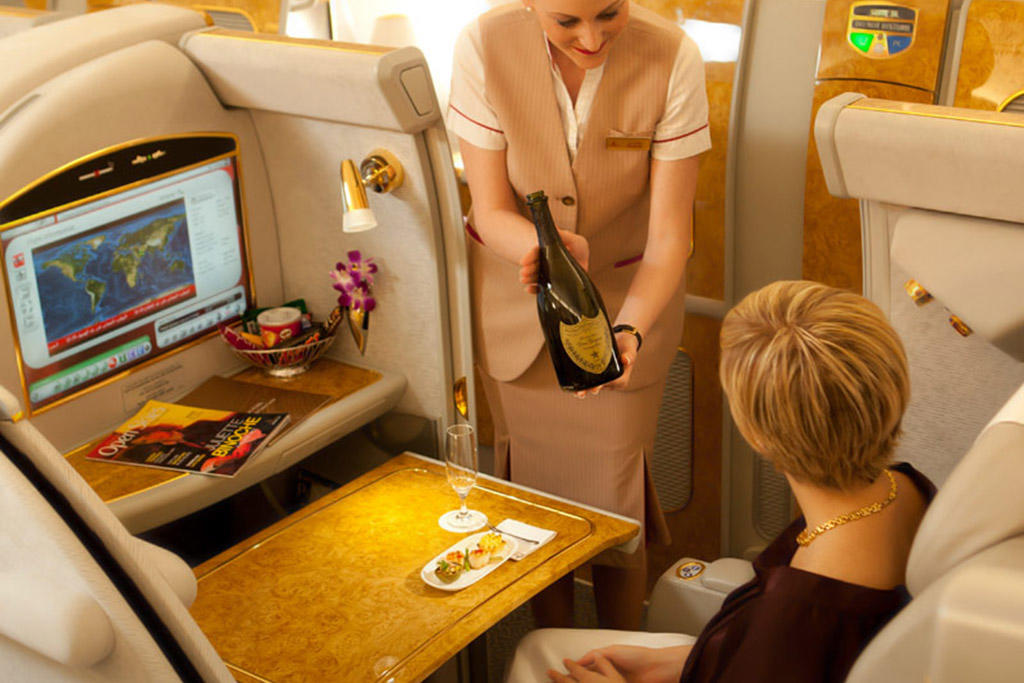
Brand Inventory
When conducting a brand audit, one of the important areas is brand inventory. The process makes it possible to have a comprehensive analysis of the strategies and approaches that a company uses to promote its brand and products in the market (Perkins 78). Emirates has a unique branding strategy that emphasizes the quality of services offered. Its brand is positioned as one that offers custom-made quality services to the customers. The unique proposition can be seen in image 3 below:
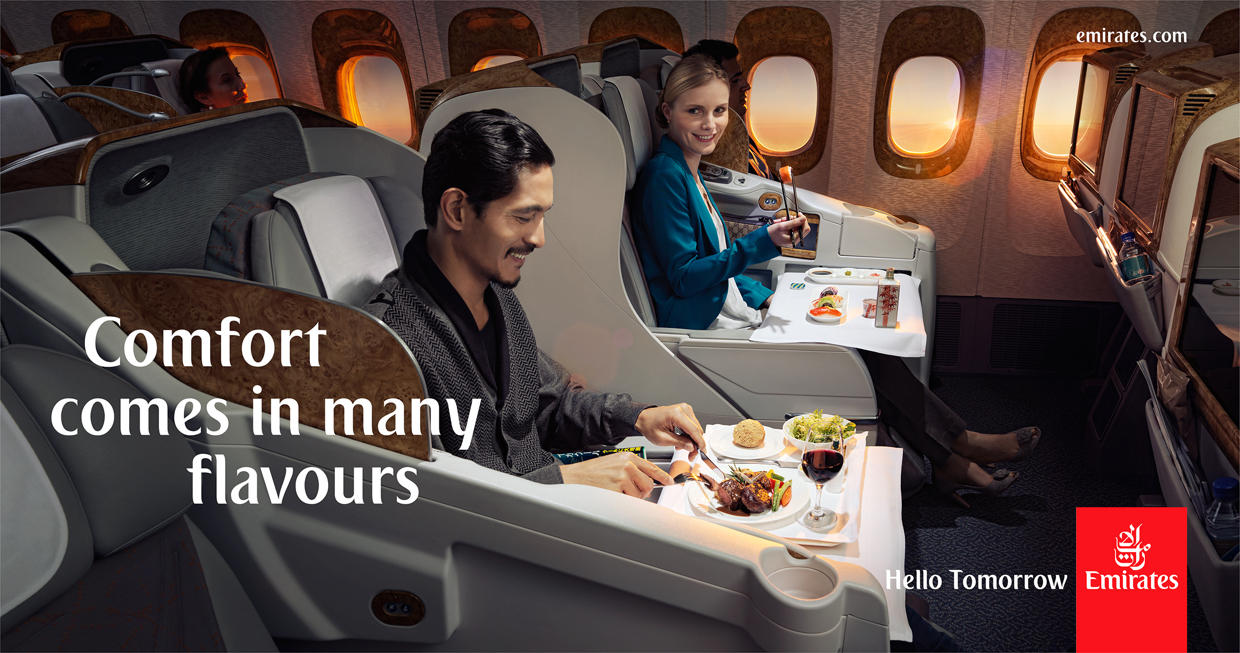
The images and the words summarize what the branding strategy for this firm is based. ‘Comfort comes in many flavors’ is the slogan that reminds customers of the commitment of the firm to offer them custom-made services that meet their needs. The images used in the advertisement demonstrate what is meant by the statement. Two travelers of different races are enjoying meals that suit their needs in a serene environment. Both are happy with the services they are offered. The firm wants its customers to understand that all airlines offer travel services, but at Emirates, they get something special. They get to travel in comfort, joy, and with their needs met in the most appropriate manner possible. Differentiation is critical in this industry, and the management of this company understands the fact. It explains why the company emphasizes on how unique and superior its products are compared with what other firms offer. To them, traveling with Emirates is an experience that one would want to have often.
Brand Elements
Brand elements analysis is critical when auditing a brand. It identifies ten different elements that must be considered by a firm when trying to develop a strong brand in the market. They include the following:
Brand Identity
Brand identity, as the name suggests, are the attributes used to identify and distinguish a brand in the market. They include a brand’s logo, name, colors, and any other distinguishing feature that makes it different from that of other companies in the market. Emirates uses color, a logo, and name as key attributes that identify its brand in the market. The figure below shows how these three features are integrated to define the company’s brand.
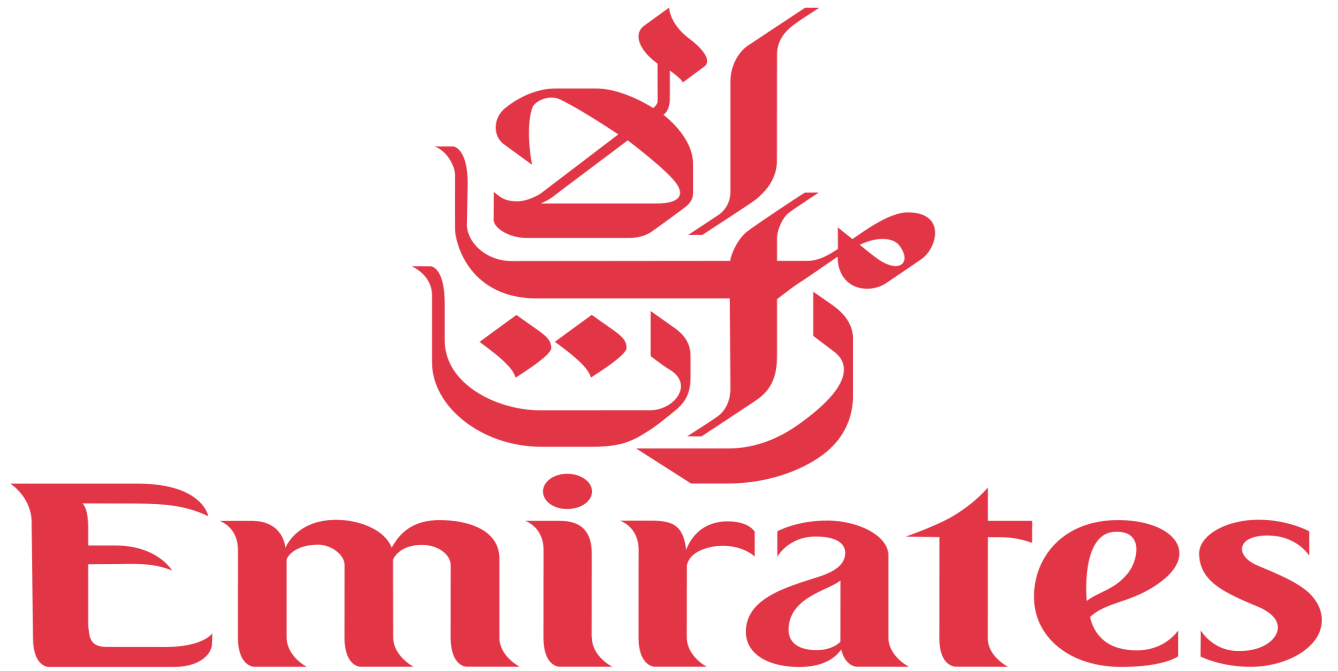
Brand Image
Brand image is the perception that is created in the minds of customers about what they expect from a brand based on the positioning strategies and the real value offered. At Emirates, comfort and leisure are the images created in the minds of customers. Most of the images that the firm uses in its promotional campaigns show the kind of leisure and comfort that its customers get. From comfortable seats to a wide range of foods and drinks, customers are assured of a memorable experience.
Brand Positioning
How a brand is positioned in the market defines its target market. Emirates positions its products in a way that targets the business class and the rich. The nature of comfort, which is often emphasized on most of the company’s products, targets regular business travelers and tourists coming to Dubai or leaving the country after their tour or business deals.
Brand Personality
Developing a brand personality is very important, especially in an industry that is as highly competitive as the aviation sector. At Emirates, the personality created is that of comfort and fun. Travelers are reminded that whenever they choose to use the services of this airline, they are assured of comfort at all times. They are also reminded that they will be entertained uniquely, using custom-made entertainment products.
Brand Equity
According to Holland and Lam, brand equity defines the value of a brand and includes both tangible and intangible benefits (21). Emirates’ brand equity is discussed in detail in the chapter that follows.
Brand Experience
The process of purchasing and consuming a given product comes with a unique experience. As Roll observes, a brand experience is purely based on the views and thoughts of customers before, during, and after making their purchases (39). At Emirates, many of its customers state that it is fun flying in their planes (Bamber et al. 45). Irrespective of the class, customers of this company often feel that genuine efforts have been made to ensure that travelers are entertained throughout their journey.
Brand Differentiation
In the aviation industry, differentiation is one of the critical activities of the marketing department. The management of Emirates has come up with various strategies to differentiate their brand from that of its rivals. The differentiation is not just exhibited in the brand identity elements (the name, logo, slogan, and color) but also in the products offered. Customers should feel the unique value offered by the brand.
Brand Communication
Developing unique products and strong brands need an effective communication platform. Customers should constantly be reminded of the brand and its unique attributes. Emirates uses both mass and social media to reach out to its customers. Most of the commercials are delivered through television advertisements. However, the firm is also considering the use of social media, especially YouTube and Facebook as platforms that can enable it to communicate with its customers.
Brand Gap
The gap between what a firm promises its customers and what is delivered may affect the loyalty of clients towards a given brand. Emirates has been working tirelessly to ensure that its customers are offered what they are promised (Bamber et al. 78). It helps in reducing post-purchase dissonance among its loyal customers.
Brand Extension
It is sometimes necessary to diversify the product portfolio to increase a firm’s sources of revenue. Besides the passenger services, Emirates also offers cargo services to its customers. Catering services are also available for its onboard customers.
Brand Equity through the Marketing Mix
When conducting a brand audit, brand equity analysis is one of the important stages that should be given priority. Looking at the tangible and intangible value derived from a brand helps in understanding how it benefits a given company. In this analysis of brand equity, the focus will be on the marketing mix elements:
Product
The product is the most basic element in the marketing mix. It is what a given firm has to offer to its customers. The nature of a product and how it meets the needs of its customers define the value that customers attach to it. Sometimes a perceived value may be created of a product based on the kind of advertisements. At Emirates, there are three primary categories of products that it offers to its customers. The first and primary product is passenger flight services. Emirates operates 100 Airbus A380 planes specifically meant for carrying passengers, making it the world’s largest operator of this type of plane (Emirates Group 56).
It also has a fleet of 130 Boeing 777 serving various customer needs. The passenger planes are given a unique interior design that makes them unique. One of the unique characteristics of these planes is that travelers are allowed ample space to make the entire process of traveling less tiring. Passengers can easily move and adjust their positions irrespective of the class they are flying. The company has given a special focus on entertainment for its travelers. A passenger can watch a preferred movie or listen to music without affecting the next passenger. The entertainment is designed to be controlled by the customer. Passengers flying business class or first class can easily sleep while flying, just to make the journey a memorable experience. Figure 5 below shows a customer in a business class enjoying a cup of coffee while relaxing on an adjustable seat/bed.
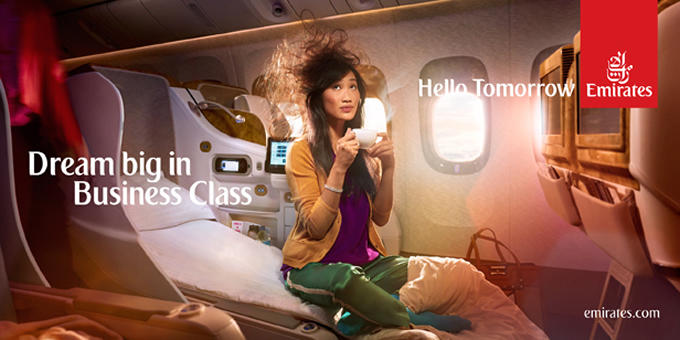
Emirates also offers cargo services to its customers. The city of Dubai has become a global business hub that attracts traders from all over the world, especially the Far East. It is currently the largest cargo service provider in the region. It carries a wide range of products from Dubai to North American, Australia, Europe, the MENA region, and various African destinations. In most of the cases, the cargo department often works closely with the top local and international logistics companies to facilitate the transport of various products to and from Dubai. It works closely with FedEx Corporation and DHL Express to ensure that goods are packed and delivered to the right destination within the desired time. It also accepts cargo from individual business people who may not want to engage the other international logistics companies.
Emirates Flight Catering is another product line that has gained popularity since it was founded in 2003. The new line of products was launched after it became evident that the companies contracted to offer catering services to passengers using Emirates Airline were underperforming. Cases of delay or delivery of low-value products were common. The management of Emirates decided to create a new line of products to address the challenges that were being experienced at that time. The products offered by this department have achieved massive success, especially because of the diversity. Customers can order from a wide range of food products while on board. They can also have drinks as long as they do not get intoxicated. The figure below shows the catering services available at Emirates Airline:

Price
The pricing element of a marketing mix is important and needs careful planning. In many cases, the price of a product is believed to define the value that it offers. Pricy products are often associated with a high value. However, it does not mean that a company can arbitrarily decide to charge high prices for its products to emphasize the value. It takes time for a company to set a high price and attract customers at the same time. In most cases, it depends on a firm’s brand. Trusted brands such as Emirates attract respect and admiration from customers. The perceived quality that the company offers and the length of time it has been in the market offering the same service makes it easy for the brand to be trusted. The three categories of products are often priced to reflect the value that they offer and to ensure that majority of the targeted customers can afford to purchase them.
According to Andersen and Poulfelt (81), Emirate’s first-class ticket is one of the world’s most expensive, at about $ 28,000 for a trip from Dubai to New York or back. The high price of the product reflects the state-of-the-art amenities at the disposal of the traveler. However, the company charges an average market price for the economy class ticket. Most of the economy class travelers are sensitive to price and often look for opportunities to get the best value at the lowest price possible. The cargo services are also priced within the average market range. The catering services are priced differently within the same flight based on the class a passenger is flying and the nature of service they desire. For the economy class travelers, the catering services are priced at the lowest level. Most of them order for simple meals and drinks that would enable them to stay comfortable for the rest of the journey. On the other hand, clients flying first class are charged the highest price within the same flight (Roll 81). Most of them demand custom-made catering services, with stand-by caterers who must respond to their needs at all times. They often demand a wide variety of meals and drinks that justifies the high prices charged. They have the means to pay, so it is not always a challenge. The passengers flying business class are charged prices slightly higher than that of the economy class travelers but below that of the first class. The strategy emphasizes the need to set prices that are affordable to the clients and reflect the value of services offered.
Place
When analyzing the marketing mix elements, the place factor is one of the elements that should be examined. A firm may have great products, but if they are not made available to the customers at the right time and in the right place, they cannot be purchased. The management of Emirates has been keen on ensuring that its products are reliably made available to its customers at the right place and in the right manner. Given the nature of products offered by this company, its services can only be offered in specific places, airports. The main hub for Emirates is Dubai International Airport. Most of the administrative activities take place at this hub which also acts as its headquarters. Customers planning to travel to various parts of the world while in Dubai must visit the airport.
The airline also has its products available to clients in various parts of the world. In Europe, the services of this company can be accessed from Glashow Airport in Glasgow and Heathrow Airport in London. In North America, Emirates Airline operates at Toronto Pearson International Airport, O’Hare International Airport, John F. Kennedy International Airport, Los Angeles International Airport, and Washington Dulles International Airport (Emirates Group 56). In South America, passengers can access their services at Rio de Janeiro-Galeoa International Airport and San Paulo-Guarulhos International Airport (Emirates Group 58). In the Far East, it is at Beijing Capital International Airport, Shanghai Pudong International Airport, Kansai International Airport, and Narita International Airport.
In Africa, they have made their services available at Jomo Kenyatta International Airport, Cairo International Airport, Addis Ababa Bole International Airport, Nnamdi Azikiwe International Airport, and Cape Town International Airport (Emirates Group 61). It is important to note that the plane flies to most of the countries in North and South America, Europe, Asia-Pacific, Africa, and the Middle East. All the catering services offered by the firm are available on the plane. Once customers are on board the planes, the meals are delivered to them by making an order. It is important to note that the physical location of the airports cannot be adjusted as would be desired by either the customers or the airline companies. Customers have to be physically present at these airports to get the travel services they need.
When analyzing the place element, the locations where customers can purchase their tickets are also important. In the past, customers had to physically visit the offices of Emirates at these major airports or specific locations in major urban centers to make their purchase. Although these physical offices are still offering these services, the company has moved a step further to enhance the process of selling its tickets to customers. Customers can now visit the website of the company, check the availability of seats, and make their purchases online without having to make any physical movement. The firm has developed a system that allows the customers to make online payments and book their seats. The approach has improved the experience of customers because they only need to be physically present at the airport on their day of travel. After booking the ticket, they can make follow-ups on the online platform and get necessary updates about the planned flight.
Promotion
Promotion is a very important activity and an element in the marketing mix. In the past, promotions were not a priority when the level of competition in the market was relatively low. After developing a product and making it available in the market, companies did very little to promote sales because customers had limited choice. However, that is not the case in the current competitive business environment. After developing a superior product and making it available conveniently to customers, it is critical to ensure that they are made aware of its existence, its superiority, and the value it offers. Emirates has elaborate marketing strategies meant to promote its products and brand in the market. One of the main strategies that the firm uses is sponsorship.
The management of the company has been keen on sponsoring popular sports as a way of popularizing its brand in the market. Football is one of the most popular sports in the world. Emirates sponsors top football clubs in the world such as Real Madrid, Arsenal AC Milan, Paris Saint-Germain, Benfica, and New York Cosmos among others. It has sponsored various major football events such as FIFA World Cup, FA Cup, and AFC Champions League (Andersen and Poulfelt 87). In cricket, it sponsors Cricket Australia, Durham County Cricket Club among others. In rugby, it has sponsored Super League Rugby, the Washington Wolves, and the World Rugby Panel (Bamber et al. 89). The approach of sponsoring major teams and tournaments helps in strengthening the brand.
The company has also identified several brand ambassadors to help promote its brand. In most of the cases, its ambassadors are well-known celebrities in the entertainment or sporting sectors. The current brand ambassador for the company is a popular American actress, Jennifer Aniston pictured in figure 7 below. The ambassadors help in reassuring the customers about the quality that the firm offers. According to Andersen and Poulfelt, Emirates airline uses various platforms to reach out to its customers (44). In the mass media, the firm has majorly been using television commercials. In social media, the firm is currently using YouTube, Facebook, and Twitter for its promotional campaigns.
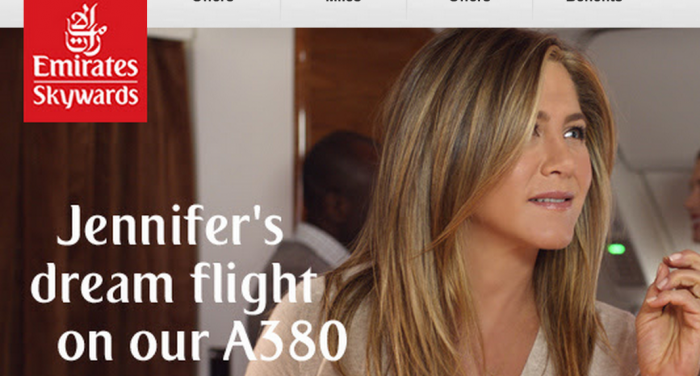
Strategic Recommendation
The aviation sector is one of the most competitive industries in a modern global society. Numerous airlines have emerged keen on tapping into the huge opportunity in the market. The industry is also faced with numerous challenges such as volatility in international oil prices, economic recessions, the emerging problems of terror attacks and cyber terrorism, erratic government policies, and many other issues that may disrupt normal operations (Perkins 67). The management of Emirates needs to have a proper plan for managing these issues to be in a position to maximize the opportunities available in the market. Embracing specific strategic recommendations will help in achieving the desired goals. The management of Emirates should take into consideration the following strategic recommendations:
- A strategic alliance is currently one of the most popular strategies in the aviation sector. This firm should consider viewing some of its top market rivals as potential strategic partners that can help it achieve greater growth. Competitors such as British Airways, Lufthansa, and Virgin Atlantic can become great business partners that can help in various settings. In case of overbooking, these partners can have an agreement on how the excess passengers can be flown in the other airlines to eliminate dissatisfaction. They can also make arrangements to enable passengers to proceed on their journey using the alternative airline without having to face the problem of booking for new tickets.
- The firm should consider developing a close business relationship with the top hotels in Dubai and major cities across the world. The business relationship will be mutually beneficial when the involved parties share customers. The hotels can recommend the Emirates brand to its customers. On the other hand, Emirates will be recommending these hotels to travelers.
- The management should enhance its security system to avoid any possible breaches. It may be necessary to embrace the new technologies in the security sector to ensure that passengers and cargo are subjected to a thorough search to eliminate any threat. Platforms should be established to ensure that employees of this firm can closely coordinate to enhance security within the planes. The company may need to work closely with other airlines, the management of the airports, and government authorities to ensure that security is enhanced.
- The management of Emirates needs to ensure that its employees are constantly motivated and not overworked. In the past, some pilots and flight attendants at the company complained of being overworked by the company. Such complaints should be effectively addressed. The firm should hire adequate staff to avoid overworking sensitive employees such as pilots and flight attendants. The employees should be regularly taken through training to ensure that they are empowered.
Tactical Recommendation
The analysis of Emirates business strategies shows that the firm is making impressive growth in the market despite the challenges that exist. The management has understood the forces in the market and is putting in place systems and structures to ensure that sustainable market growth is achieved. The company has experience of over 32 years in the market, and that is often expressed in its effective operational strategies. However, it may be necessary to reconsider some of the approaches based on emerging technologies, security threats, and increasing levels of competition in the market. The following tactical recommendations should be considered by the management of this company:
- The management of the airline should consider having its technology-based security checks for the passengers boarding the planes. Cases of a security breach at the airports are common. In some cases, criminals and terror groups collude with the airport security officials to smuggle weapons or dangerous items to the planes. To ensure that the security of passengers and property is guaranteed, the planes should have the final check as the passenger board.
- The management should consider hiring highly trained combat officers who should always be on board the planes. The officers should be strategically within the plane, in plain clothes, ready to tackle any threat that may emerge from any of the passengers onboard the plane.
- The management will need to ensure that customers can give their feedback about the products offered by the firm. Any concern raised by these travelers should be addressed within the shortest time possible and in an effective manner.
Works Cited
Andersen, Michael, and Flemming Poulfelt. Beyond Strategy: The Impact of Next Generation Companies. Routledge, 2014.
Bamber, Greg, et al. Up in the Air: How Airlines Can Improve Performance by Engaging Their Employees. Cornell University Press.
Emirates Group. Annual Report 2016-2017: Accelerating. Emirate Group, 2017.
Holland, Ray, and Busayawan Lam. Managing Strategic Design. Palgrave Macmillan, 2014.
Mootee, Idris. 60-minute Brand Strategist: The Essential Brand Book for Marketing Professionals. Wiley, 2013.
Perkins, Lauren. The Community Manager’s Playbook: How to Build Brand Awareness and Customer Engagement. Springer, 2015.
Roll, Martin. Asian Brand Strategy: Building and Sustaining Strong Global Brands in Asia. Palgrave Macmillan, 2015.
Trott, Sangeeta. Brand Equity. Prentice-Hall of India, 2016.